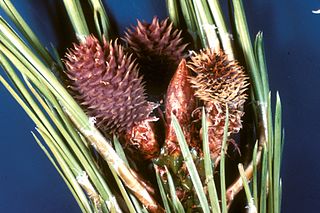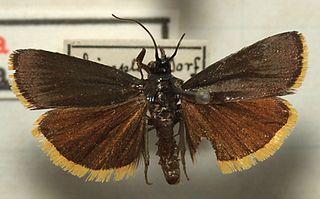
Dioryctria sylvestrella, the new pine knot-horn or maritime pine borer, is a moth of the family Pyralidae. It is found in Europe, parts of Asia and North Africa. The adult is a small mottled brown and white insect with a wingspan of 28 to 35 mm. The moth flies in a single generation from June to October and is a pest of maritime pine and several other species of pine, on which the caterpillars feed.

Idia is a genus of litter moths of the family Erebidae first described by Jacob Hübner in 1813.

Dioryctria is a genus of snout moths. It was described by Philipp Christoph Zeller in 1846.

Dioryctria auranticella, the ponderosa pineconeworm moth, is a moth of the family Pyralidae. The species was first described by Augustus Radcliffe Grote in 1883. It is found in western North America from southern British Columbia south to California and Arizona, east to South Dakota and New Mexico.

Dioryctria ponderosae, the ponderosa twig moth, is a moth of the family Pyralidae. The species was first described by Harrison Gray Dyar Jr. in 1914. It is found in North America from Washington and Montana south to California and northern Mexico.

Dioryctria reniculelloides, the spruce coneworm, is a moth of the family Pyralidae. The species was first described by Akira Mutuura and Eugene G. Munroe in 1973. It is found from Nova Scotia to Alaska, south in the east to New York, and south in the west to California and New Mexico. It was recorded from China in 2009. Occasionally abundant, often in conjunction with epidemics of the spruce budworm, the spruce coneworm occurs through most or all of the range of spruce in North America, feeding on new foliage and cones of spruce, and often balsam fir. When abundant, it can be a serious pest "particularly on white spruce".

Dioryctria disclusa, the webbing coneworm or rusty pine cone moth, is a species of moth of the family Pyralidae. It is found in North America from New Brunswick to Florida, west to Texas and north to Manitoba.

Catastia is a genus of snout moths. It was erected by Jacob Hübner in 1825, and is known from Bosnia and Herzegovina, Austria, Italy, and Greece.
Catastia incorruscella is a species of snout moth in the genus Catastia. It was described by George Duryea Hulst in 1895. It is found in North America, including Colorado, Utah and California.
Coenochroa illibella, the dune panic grass moth, is a species of snout moth in the genus Coenochroa. It was described by George Duryea Hulst in 1887. It is found in North America, including Texas, Arizona, Colorado, California, Indiana and Ontario.

Dioryctria abietivorella, the fir coneworm, is a species of snout moth in the genus Dioryctria. It was described by Augustus Radcliffe Grote in 1878, and is found in North America from southern Canada south to California in the west and North Carolina in the east.
Dioryctria cambiicola, the western pine moth, is a species of snout moth in the genus Dioryctria. It was described by Harrison Gray Dyar Jr. in 1914 and is found in North America from British Columbia and Alberta south to California and New Mexico.
Dioryctria gulosella is a species of snout moth in the genus Dioryctria. It was described by George Duryea Hulst in 1890 and is known from the United States, including Colorado, New Mexico and California.
Dioryctria pygmaeella, the baldcypress coneworm moth, is a species of snout moth in the genus Dioryctria. It was described by Émile Louis Ragonot in 1887 and is restricted to the coastal plains of the eastern United States and eastern Texas.
Dioryctria taedivorella, the lesser loblolly pineconeworm moth, is a species of snout moth in the genus Dioryctria. It was described by Herbert H. Neunzig and Nancy Antoine Leidy in 1989, and is known from North America, where it is found from eastern Virginia and North Carolina to northern Alabama and Mississippi.
Dioryctria tumicolella is a species of snout moth in the genus Dioryctria. It was described by Akira Mutuura, Eugene G. Munroe and Douglas Alexander Ross in 1969, and is known from British Columbia, Canada, but is possibly present in all of north-western North America.
Dioryctria yatesi, the mountain pine coneworm, is a species of snout moth in the genus Dioryctria. It was described by Mutuura and Munroe in 1979, and is limited to the mountains of the coastal south-eastern United States and Tennessee.
Eumysia pallidipennella is a species of snout moth in the genus Eumysia. It was described by George Duryea Hulst in 1895. It is found in the US state of California.
Oneida luniferella is a species of snout moth in the genus Oneida. It was described by George Duryea Hulst in 1895. It is found in the western part of the United States and Mexico.
Caberini is a tribe of geometrid moths in the family Geometridae. There are at least 50 described species in Caberini.








